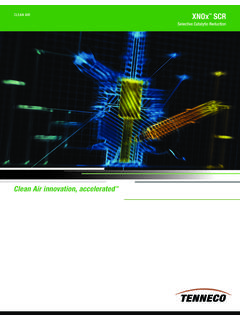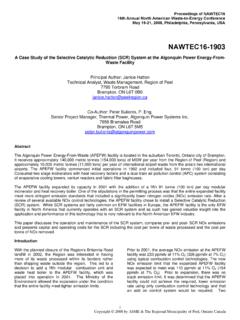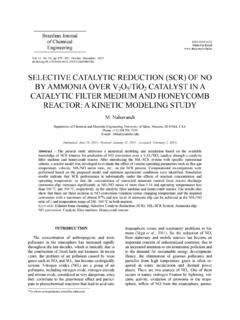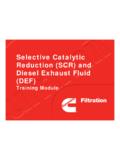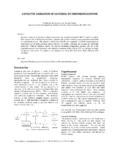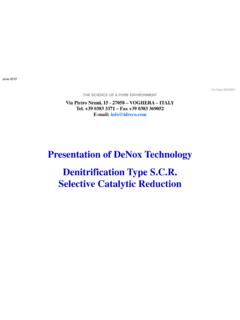Transcription of Selective Non-catalytic Reduction (SNCR) and its ...
1 CHEMICAL ENGINEERING TRANSACTIONS VOL. 56, 2017 A publication of The Italian Association of Chemical Engineering Online at Guest Editors: Ji Jarom r Kleme , Peng Yen Liew, Wai Shin Ho, Jeng Shiun Lim Copyright 2017, AIDIC Servizi , ISBN 978-88-95608-47-1; ISSN 2283-9216 Selective Non-catalytic Reduction (SNCR) and its Efficiency with Respect to Various Combustion Parameters Pavel Gal*, David Jecha, Jaroslav J cha, Petr Stehl k Institute of Process and Environmental Engineering, Faculty of Mechanical Engineering, Brno University of Technology, Technick 2, 616 69 Brno, Czech Republic Nitrogen oxides, which are formed for example during the combustion process in coal power plants, have negative impact on the environment.
2 It is one of the main components of greenhouse gases and together with sulfur oxides cause acid rains. When reducing the formation and discharge of nitrogen oxides, it is possible to proceed several technological processes. One of the methods that is used in practice for reducing these pollutants, is Selective Non-catalytic Reduction (SNCR). Increasingly stringent emission limits forcing businesses to invest in a system for removing NOx. SNCR method is one of the cheapest, but sufficiently effective alternative to achieve these levels. This contribution describes the experimental tests of injecting a reducing agent into the flue gas stream.
3 In this case a reducing agent (with the trade name Satamin) consisting of an aqueous urea solution and an additives. The tests were performed in the boiler K14 at the power plant in Ostrava - T ebovice, CZ. The aim of the tests was to reduce NOx emissions achieved by primary measures ( , adjusting the pressure of the boiler unit, low NOx pulverised coal burners, change media for grinding mill circuits) so that the flue gas at the outlet reaches approximately 190 mg/mN3, because NOx emission limit specified by legislation is established to 200 mg/mN3. Efficiency SNCR was determined based on the conversion rate of Satamin and the associated Reduction of primary NOx to a final value measured at a chimney.
4 The contribution shows and compares the impact of various factors (the concentration of CO in the flue gas stream, the primary value of NOx, the temperature in the combustion chamber, etc.) that affect, positively or negatively, the reaction process of Satamin and NOx according to the equations (Dvo k, et al., 2010): 4 +2 ( 2)2 + 2 2 + 2 4 2+6 2 +2 2 (1) 6 2+4 ( 2)2 + 4 2 7 2+12 2 +4 2 (2) Non-catalytic Reduction (SNCR) is one of the denitrification methods, which belongs to the secondary measures. Operation costs of SNCR are lower than SCR and also efficiency is very different. Average efficiency for SCR is about 92 % (with fixed bed catalytic reactor), however for SNCR is mostly about 55 % (European IPPC Bureau, 2014).
5 It depends on boiler condition and significantly on temperature at level of dosing reducing agents ( ammonia and urea). Suitable range of temperature is called temperature window. Reduction by applying urea is usually done in ranging from 950 C to 1,050 C (European IPPC Bureau, 2014). Urea reacts with NOx contained in flue gas. The most amount of NOx is represented by nitric oxide (NO), however other oxide, as nitrogen dioxide (NO2) or nitrous oxide (N2O), take only few percent of NOx (Dvo k, et al., 2010). Desired reactions between NOx and urea solution is Eq(1) and Eq(2) (Dvo k et al., 2010). If temperature in dosing zones reaches out of temperature window undesired reactions Eq(3), Eq(4), Eq(5) proceed (Kanniche et al.)
6 , 2011). Urea doesn t react when temperature is below range and causes ammonia slip. Over the range reductant burns and the amount of NOx increases. 4 +4 3+ 3 2 4 2 +6 2 (3) DOI: Please cite this article as: Gal P., Jecha D., J cha J., Stehl k P., 2017, Selective Non-catalytic Reduction (sncr) and its efficiency with respect to various combustion parameters, Chemical Engineering Transactions, 56, 1915-1920 19154 3+ 5 2 4 +6 2 (4) 4 3+ 3 2 2+6 2 (5) Limit of NOx emission for coal power plants stipulated by Czech legislation is 200 mg/mN3 (Czech Government Regulation 352/2002 Sb.). In the present it doesn t define any limit of ammonia slip.
7 Acceptable value of ammonia slip was determined under 5 mg/mN3. 2. Boiler unit and combustion process Measurements were carried out in the boiler K14, which is part of the production block of power plant T ebovice. It is a steam coal boiler (hard coal) with a dry bottom furnace. Steam boiler capacity is 110 t/h to 220 t/h. The outlet temperature and pressure is 535 C and MPa. Description of boiler unit Coal dust is prepared in two grinding mill circuits (GMC) for burning. Milling circuits are independent on each other. Boiler system consists of 18 burners (Figure 1) - 12 pulverised-coal burners (numbers 1-12), 2 start-up and stabilising burners and 4 waste-vapour burners (A - D).
8 Pulverised-coal burners are located at the corners of the boiler unit in three levels. Waste-vapour burners lead into the boiler waste vapours (preheated air containing particles dedusted in cyclones), which are dosed between the middle and upper level of the pulverised-coal burner (see Figure 1). Stability of the flame is checked by 8 pyrometers disposed between the upper and middle levels of burners. Additional air is delivered into the fireplace. These are called over fire air - OFA, which is important in terms of NOx Reduction . Figure 1: Placement of burners and SNCR method in boiler unit Description of flue gas cleaning Part of the gas cleaning system except SNCR technology is also electrostatic precipitator and DeSOx technology to eliminate emissions of SO2, which is implemented by dosing sorbent into the flue gas.
9 In the combustion chamber (at a height of m) is the flue gas temperature measured using the AGAM system (acoustic gas temperature measurement) with six sensors. Measuring emissions of NH3 slip is implemented by a diode laser spectrometer (LDS 6). As emissions are measured before entry into the chimney, ammonia can be partially dissociated on the filter in the form of salts. Despite the value of NH3 slip is one indicator of the effectiveness of SNCR technology. The reducing agent may be dosed into one of two zones, which are at a height of 18 m and m above the furnace. There are six nozzles in each layer (three on the right and left side of the boiler).
10 The Reduction mixture, consisting of demineralised water and satamin (40 % an aqueous urea solution), is in the nozzle to enlarge the interphase interfaces broken atomising air to fine drops. At the ends of the nozzles special angled nozzles are installed, which with their design regulate drops trajectory. Thanks to this change, the reducing agent gets in lower flue gas temperature and achieves better conversion of chemical reaction. Switching between zones is automated based on steam output or the temperature in the combustion chamber. Limits for switching to individual layers are described in Table 1. The level switches when the current value of the output or the temperature exceeds the limit.










